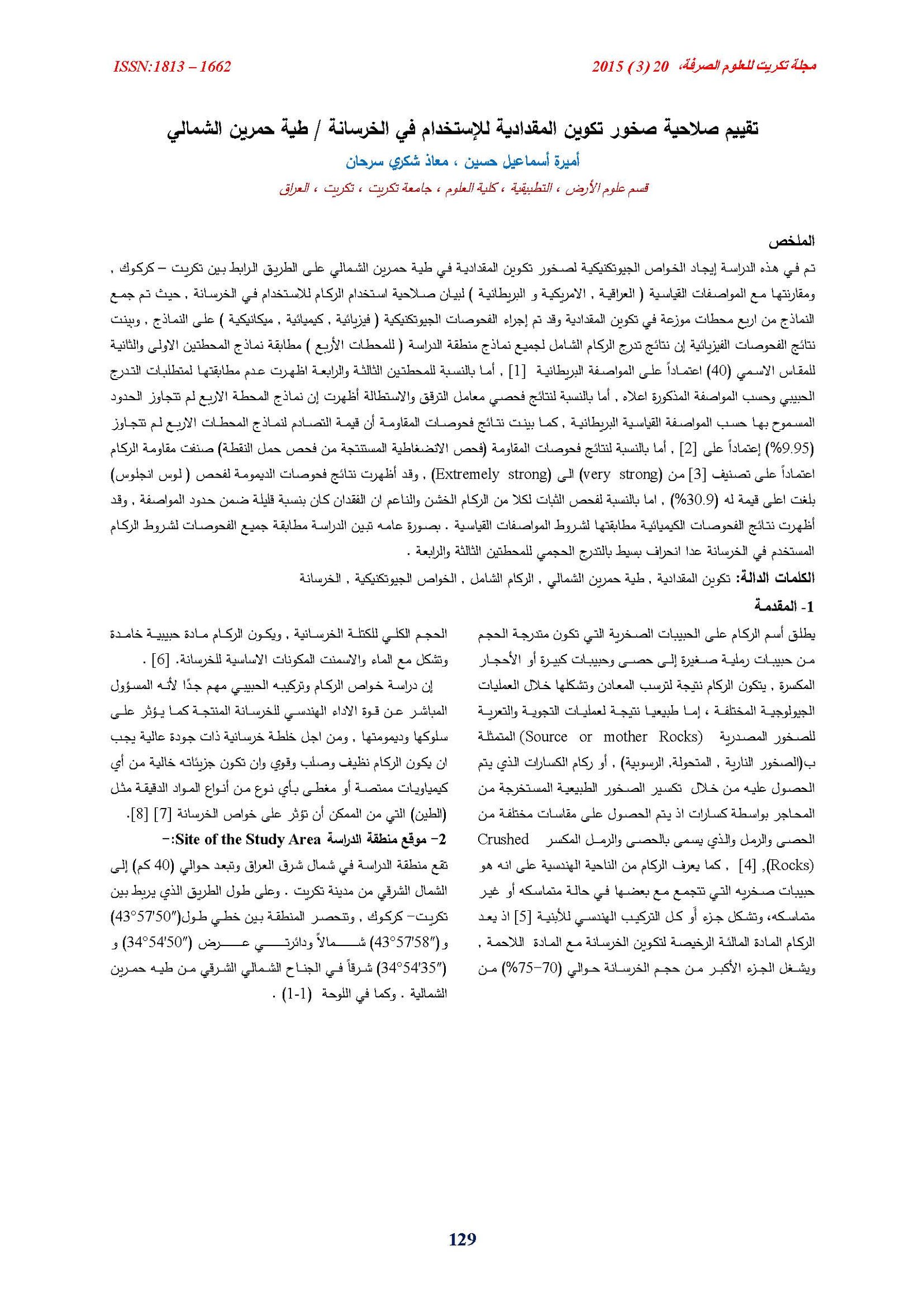Evaluation of the Suitability of Mukdadiya Formation Rocks for Using in Concrete / Northern Hemrin Anticline
Main Article Content
Abstract
The aim of this work is to evaluate the suitability of gravely sediments of the Mukdadiya formation (Lower Pliocene) in the northern Hemrin anticline on Tikrit – Kirkuk road / north-eastern of Iraq for concrete uses , and compared with the standard specifications (Iraqi, American and British) samples have been collected from four different stations by two samples for each station for the purpose of conducting various geotechnical tests including physical tests , strength and durability as well as chemical tests) Results of geotechnical evaluation for physical tests show that the grain size distribution of the 1st and 2nd stations suitable for uses to concrete for classes (40) class except 3rd. and 4th station , according to[1] , the results of Flakiness Index and elongation Index shows that the samples of four stations did not exceed the permitted border According to the British Standard and suitable to be provided by the requirements for the use of concrete .
The strength tests also showed the results of (AIV) shows it's don’t exceed than 9.95%) for all sample in the study area , and for compressive strength that taken from point load test shows that all stations classified the aggregate strength (very strong - extremely strong) according to[3] .
Durability geotechnical tests (Loss Angeles) results shows the percentage of weight loss for the four samples are not exceed the defined value 35% , so it is suitable for use for concrete and sub-base coarse aggregate and soundness test results shows suitability of all samples to use in concrete works .
The chemical analysis shows suitability according to the standards .
Overall, the study showing suitability for all tests with the requirements of the aggregate that are used in concrete except simple deviation in the grain grading in the third and fourth station .
Article Details

This work is licensed under a Creative Commons Attribution 4.0 International License.
Tikrit Journal of Pure Science is licensed under the Creative Commons Attribution 4.0 International License, which allows users to copy, create extracts, abstracts, and new works from the article, alter and revise the article, and make commercial use of the article (including reuse and/or resale of the article by commercial entities), provided the user gives appropriate credit (with a link to the formal publication through the relevant DOI), provides a link to the license, indicates if changes were made, and the licensor is not represented as endorsing the use made of the work. The authors hold the copyright for their published work on the Tikrit J. Pure Sci. website, while Tikrit J. Pure Sci. is responsible for appreciate citation of their work, which is released under CC-BY-4.0, enabling the unrestricted use, distribution, and reproduction of an article in any medium, provided that the original work is properly cited.
References
1. B.S 882, (1992):- " Specification for aggregate from natural sources for concrete".
Aggregate Impact Value 5 ا.
3. Hawkins, A. B., 1986:- "Rock Description ", Geological Society, Engineering Geology, Special Publication , No. 2, pp. 59-72 .
4. BGS (2009) British Geological Survey. Online at: http://www.bgs.ac.uk/ [accessed on27.02.2009].
5. Smith ,M.R, & Collis.L , (2001): "Aggregate sand , gravel and crushed rock aggregate for construction purposes", 3rd Edition, geological society Engineering Geology Special Publication no,17,
London, 331p.
6. Neville ,A.M., Brooks, J.J(,2010):- "Concrete Technology" ,2nd Edition, England, 442p.
7. McNally, G.H., (1998):- "Soil and Rock Construction Materials", First published 1998, E & FN Spon, an imprint of Routledge, New Fetter Lane, London EC4P , 401p
8. Neville, A.M , (1996) "Properties of Concrete", 4th Ed., Pitman Publishing Ltd., London.
9. Bellen, R. C. Van, H. V. Dunnington, Wetzel, R. and Morton, D., (1959)- :"Lexique Stratigraphique International".vol3, Asie, Fasc. 10a. Iraq, Paris, 333p
10. Buday, T.,& Jassim, S. Z (1980),:- "The Regional geology of Iraq. Stratigraphy and paleogeography, Dar Al- Kutub pub. House. University of Mosul", Iraq. 445p
11. Busk, H.G., Mayo, H.T., (1918):Some notes on the geology of the Persian oil Welds", Journal Institute Petroleum Technology V 5, No 17 p3–26.
12. Jassim, S.Z., and Goff, J.C., 2006. Geology of Iraq, Published bu Dolin, prague and Musem, Brno Czech Republic, 2006, 337p.
13. Al-Rawi, Y.T., Sayyab, A.S., Jassim, J.A., Tamar-agha, M.Y., Al- Sammai, A.I., Karim, S.A., Basi., M.A., Dhiab, S.H., Faris, F.M., and Anwar, F., 1992. New Name for Some of the Middle Miocene-Pliocene Formation, Iraqi Geological Journal Vol. 1, pp. 1-18.
16. Buday, T., 1973. Regional geology of Iraq. NIMCO., Unpub., Baghdad, Iraq.
18. Barwari, A., M., 1991, The Geology of Mandli Quadrangle sheet (NI-38-11), scale, 1: 25oooo, GEOSURV, lib. Reporte No. 2227 , Baghdad, Iraq.
19. Buday, T., and Jassim, S. Z., 1984. Final Report and the Regional Geological Survey of Iraq, Unpublished Report, S.O.M Library, Vol.2, Tectonic Framework.
25. American Society for Testing and Materials (ASTM) D 75 – 03 (2004): "Standard Practice for Sampling Aggregates", Volume 4, 1-5 p.
28. BS 812-105-105.1:1985, Testing aggregates. Methods for determination of particle shape. Flakiness index
29. American Society for Testing and Materials (ASTM) C 127 – 88 (Reapproved 2001) , 2004 : "
Standard Test Method for Specific Gravity and Absorption of Coarse Aggregate" , Volume 4, 1-5 p.
30. American Society for Testing and Materials (ASTM) C 131 –96(2004) : " "Standard Test Method for Resistance to Degradation of Small –Size Coarse Aggregate by Abrasion and Impact in the Los Angeles Machine", Volume 4, 1-4 p.
31. American Society for Testing and Materials (ASTM) C88-05 (2004): "Standard Specification for Materials of Test of soundness of aggregate by use of soium sulphate & magnesium sulphate ", Volume 4, 1-3 p.
33. B.S. 1377;1990: - "Method of determination of Organic Matter in aggregate"
